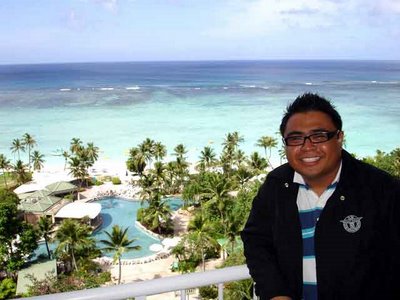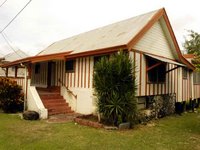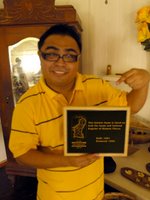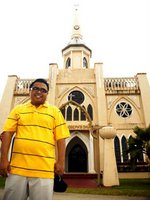 Today, we left Guam for Saipan. Our flight was in the afternoon so we had some last minute meetings before we flew out. After breakfast, we made a courtesy visit to Walter B. Dias, the Staff VP for Sales and Marketing of Continental Airlines. After the visit, we were invited to visit the Hyatt Regency Guam to check out the facilities and savor their sumptuous buffet lunch.
Today, we left Guam for Saipan. Our flight was in the afternoon so we had some last minute meetings before we flew out. After breakfast, we made a courtesy visit to Walter B. Dias, the Staff VP for Sales and Marketing of Continental Airlines. After the visit, we were invited to visit the Hyatt Regency Guam to check out the facilities and savor their sumptuous buffet lunch. The view from the rooms was picturesque! All their rooms are actually on the side of the beach and thus get a wonderful view of Tumon Bay. Lunch was at La Mirenda Retaurant. Everyday, the theme of the buffet changes so expect to try out something new. For today, it was Mexican so I had nachos and made my own burrito with guacamole in it. But the pièce de resistance was actually their dessert table. Yummy!
The view from the rooms was picturesque! All their rooms are actually on the side of the beach and thus get a wonderful view of Tumon Bay. Lunch was at La Mirenda Retaurant. Everyday, the theme of the buffet changes so expect to try out something new. For today, it was Mexican so I had nachos and made my own burrito with guacamole in it. But the pièce de resistance was actually their dessert table. Yummy!  We were running late and had to rush to the airport. The counters were actually closed when we got there but they let us in anyway. We were already late, but when we placed our bags on the weighing scales, everyone was overweight no thanks to the shopping! So all of us were frantically opening our luggage and taking out stuff. Good thing Lou gave us a travel bag from Continental so we were able to balance out the stuff between the two bags. Whew!
We were running late and had to rush to the airport. The counters were actually closed when we got there but they let us in anyway. We were already late, but when we placed our bags on the weighing scales, everyone was overweight no thanks to the shopping! So all of us were frantically opening our luggage and taking out stuff. Good thing Lou gave us a travel bag from Continental so we were able to balance out the stuff between the two bags. Whew!  The plane is actually a 42-seater ATR42/72, the ones with the propellers. I already had some misconceptions about these planes and was pleasantly surprised that it was a smooth flight since I had motion sickness. In fact, I was asleep for the most part.
The plane is actually a 42-seater ATR42/72, the ones with the propellers. I already had some misconceptions about these planes and was pleasantly surprised that it was a smooth flight since I had motion sickness. In fact, I was asleep for the most part. We landed at the Saipan International Airport at about 3:30 p.m. To get into the Northern Marianas, you either need a U.S. visa or a visitor's entry permit. You could get an application form at the Marianas Visitors Authority office in Manila and fax it to CNMI Immigration. Forms can also be downloaded at the website of the CNMI Attorney General's Office.
 We got a warm welcome when we got out the airport courtesy of our hosts, the Saipan Grand Hotel. They gave each of us plumeria leis which really smelled good.
We got a warm welcome when we got out the airport courtesy of our hosts, the Saipan Grand Hotel. They gave each of us plumeria leis which really smelled good.From the airport, we went to the hotel. But they took us for a brief drive around the island center in Garapan first. Our rooms had a really great view of Susupe Beach which was right beside the hotel. The group had a lot of time to rest since our only activity today was dinner. So after getting settled, I went down to the beach to swim a bit.
 We had a BBQ dinner at the beach. The atmosphere was so relaxed and we had our feet on the sand. They served us salads, roasted oysters and mussels and steak. They also let us try Tinian chili. I dipped the tip of my fork in it to try it out. Wow! The effect of that very small amount was overwhelming since the chili was just soooooo hot!
We had a BBQ dinner at the beach. The atmosphere was so relaxed and we had our feet on the sand. They served us salads, roasted oysters and mussels and steak. They also let us try Tinian chili. I dipped the tip of my fork in it to try it out. Wow! The effect of that very small amount was overwhelming since the chili was just soooooo hot! The great thing about this hotel was that they had free Wi-Fi internet access at the lobby! Hehe! Anyway, time to sleep now. Lot's of stuff to do tomorrow.































